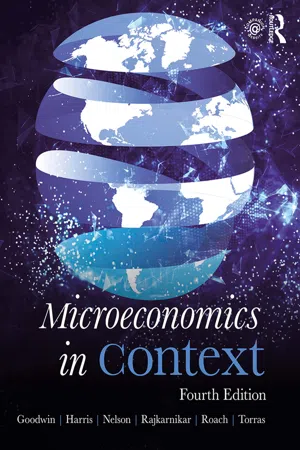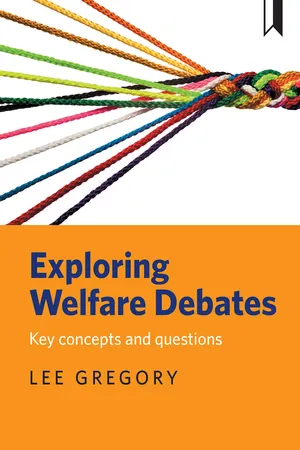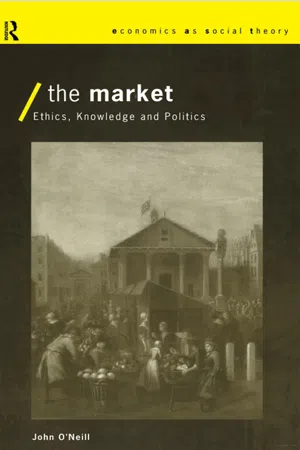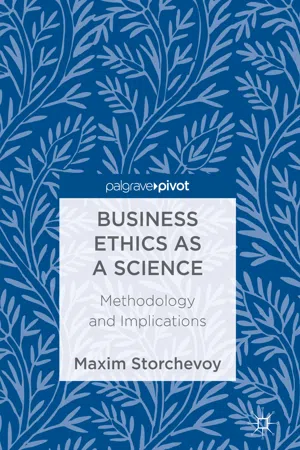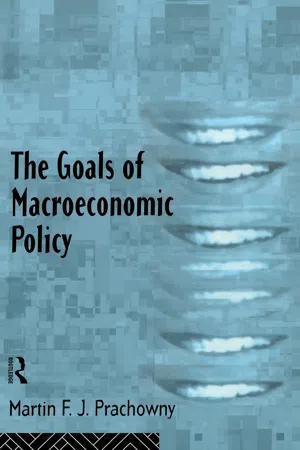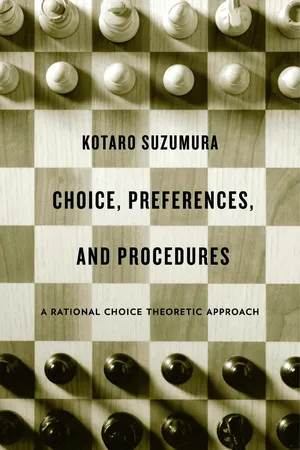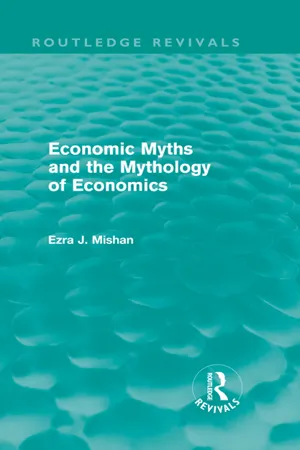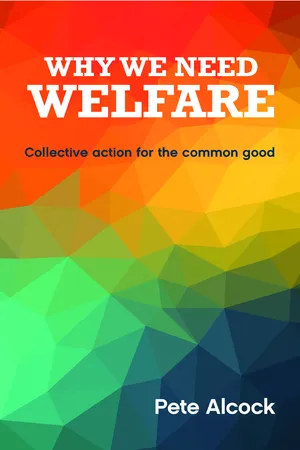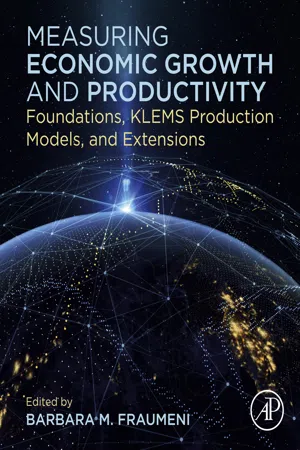Economics
Welfare in Economics
Welfare in economics refers to the overall well-being of individuals and society. It encompasses factors such as income distribution, access to goods and services, and overall quality of life. Economists study welfare to understand how different policies and market conditions impact the standard of living and social welfare of a population.
Written by Perlego with AI-assistance
Related key terms
Related key terms
1 of 4
Related key terms
1 of 3
12 Key excerpts on "Welfare in Economics"
- eBook - ePub
- Martin Binder(Author)
- 2010(Publication Date)
- Routledge(Publisher)
I start with a tentative definition of well-being and welfare (in subsection 2.1.1). In economics, well-being is often equated with utility, a vague and fuzzy notion that has undergone considerable change in its usage (subsection 2.1.2). This highlights the need for careful and unambiguous definitions when it comes to discussing the specific details of a theory of welfare (subsection 2.1.3). Subsequently, (subsection 2.1.4), some requirements are presented that comprise our toolbox to assess the adequacy of the theories of welfare presented in the following section. 2.1.1 The notions of well-being and welfare What do we mean by welfare, this ‘everyday, vague, and depressingly elusive notion’ (Griffin 1982: 332)? For a first approximation, we could consult a dictionary. The Oxford Dictionary of Economics defines welfare as ‘enjoyment of the necessary resources for a worth-while life’ (Black 2002: 502); but that seems a rather narrow focus on ‘necessary resources’. Welfare is certainly a much broader and much more central notion. As such, it is used not only in economics but plays a vital role in philosophy and ethics as well, where there exist many competing theories of welfare. Since the concept is widely used, different meanings attach to the term. What is probably common to these usages is the idea that an individual’s welfare is concerned with what it means for that individual to lead a good life. It deals with the quality of that individual’s life. When a particular individual is enjoying a high level of welfare, that individual should be able to say that life is going well. This much can already be derived from the word’s etymological roots (‘faring well’ means doing well). This aspect is also reflected in the notion of ‘well-being’: an individual’s well-being is concerned with the question of whether that individual is well. Thus welfare means doing well with respect to something - eBook - ePub
- Neva Goodwin, Jonathan M. Harris, Julie A. Nelson, Pratistha Joshi Rajkarnikar, Brian Roach, Mariano Torras(Authors)
- 2018(Publication Date)
- Routledge(Publisher)
Welfare economics is a branch of microeconomics that seeks to estimate the social welfare of different scenarios in order to determine ways to maximize net social benefits. Welfare economics can be studied from both a theoretical perspective and a quantitative applied perspective.welfare economics: the branch of microeconomics that seeks to estimate the social welfare of different scenarios in order to determine how to maximize net social benefitsAs a theoretical approach, welfare economics provides insights into situations in which markets produce desirable outcomes, as well as other situations in which markets either require policy interventions or are ineffective at meeting our final goals. As a quantitative approach, welfare economics seeks to measure social costs and benefits numerically so that different policy scenarios can be compared. Ideally, we can then choose the policy that produces the greatest social welfare.Welfare economics offers an appealing feature—the possibility of measuring the quantitative costs and benefits of different policy scenarios. If this can be done reliably, it should then be possible to simply choose the option that results in the greatest social welfare, where social welfare is defined as total benefits minus total costs, or total net benefits.social welfare: total benefits to society minus total costs, or total net benefitsSome economists use such terms as “social welfare” and “social well-being” interchangeably. However, the two concepts have a subtle, but critical, distinction. As defined above, social welfare is something that can potentially be measured quantitatively, although this approach has numerous limitations. Well-being, which we regard as the final goal of economics, is a broader concept that cannot be measured in quantitative terms. Well-being includes such objectives as fairness, participation, and social relations (recall Table 1.1 in Chapter 1 - eBook - ePub
Exploring Welfare Debates
Key Concepts and Questions
- Gregory, Lee(Authors)
- 2018(Publication Date)
- Policy Press(Publisher)
How welfare is defined is open to significant interpretation. Daly (2011), for example, outlines three foundation theories drawn from Economics, Politics and Social Policy, and shows how each perspective highlights different concerns and intents. Western societies have tended to consider gross domestic product (GDP) as a proxy for welfare, on the assumption that increasing GDP will result in shared economic benefits for all in society. This economic perspective has met with some criticism. Other concepts of welfare refer to philosophical notions of ‘the good life’ or the pursuit of a wider idea of human flourishing (rather than the scrounger idea we explored in Figure 1.1). Generally, welfare refers to a range of different forms of security; it is predominantly used in relation to material resources such as income and housing, but also increasingly in relation to other sources such as personal relationships, health and participation. This chapter traces some key aspects of the concept of welfare.Welfare as flourishing
The notion of human flourishing has a long history. It stretches back to the work of the Greek philosopher Aristotle, who was interested in the quest for the good life, which he termed eudaimonia. Eudaimonia was tied to people pursuing activities that exhibit ‘virtue’ (acceptable behaviours), so that welfare is secured through the proper development of one’s capabilities. Here, we find an explicit account of a ‘good life’, as defined by Aristotle: in essence, that we can make an external judgement of what a good life consists of and how this can then be achieved. The aim was to ensure that citizens did not squander their capabilities on activities that detracted from the good life, thus undermining the political and social community. For Aristotle, eudaimonia was based on three aspects of happiness:1. Pleasure/enjoyment; 2. A life as a free and responsible citizen (although how he defined a citizen would not reflect our concept today; I explore this in Chapter 3); and 3. A life as a thinker/philosopher. - eBook - ePub
- Randall Holcombe(Author)
- 2013(Publication Date)
- Routledge(Publisher)
8 Economic welfare Theory and policyThe subject matter of economics has always revolved around how to design policies to improve economic well-being. Indeed, Adam Smith’s complete title, An Inquiry Into the Nature and Causes of the Wealth of Nations , reveals his intention to explain how people are able to create wealth by working together well beyond what any individual could achieve alone. He begins by saying, "The greatest improvement in the productive powers of labour ... seem to have been the effects of the division of labour,"1 and goes on to give the delightful example of the pin factory in which he argues that people are hundreds of times more productive when they specialize their labor, and increase their well-being by trading with others who specialize in different productive activities. Just by looking at the prosperity that characterizes the modern world – in those parts of the world that have a well-functioning market economy – there can be no doubt that economic welfare is advanced by the results of resource allocation within a market setting.While economic welfare has always been the central subject matter of economics, modern welfare economics can trace its origins to A.C. Pigou’s The Economics of Welfare , originally published in 1920. Pigou notes that there is a difference between economic and non-economic welfare, and limits his study to the former. Neoclassical welfare economics followed Pigou’s lead in this regard, and this chapter will do the same. Pigou goes on to note, "What we wish to learn is, not how large welfare is, or has been, but how its magnitude would be affected by the introduction of causeswhich it is in the power of statesmen or private persons to call into being."2 - eBook - ePub
The Market
Ethics, Knowledge and Politics
- John O'Neill(Author)
- 1998(Publication Date)
- Routledge(Publisher)
3 ECONOMIC THEORY AND HUMAN WELL-BEING
Welfare arguments have been central to the defence of market economies. The market is an economic institution that best improves human well-being. The theme runs through economic theory from classical economists such as Smith through to modern neo-classical and Austrian schools. However, over the past century these welfarist defences of the market have exhibited a shift that is closely related to the move towards the political ideal of neutrality discussed in the last chapter. There has been a shift from arguments that employ a substantive conception of the human well-being that specify the content of what it is for humans to live well to arguments premised on purely formal definitions of well-being. That formal concept often comes under the name of utility understood in a technical sense as a preference ordering or structure. In this chapter I will examine the reasons offered for that shift and suggest that they are unsound. I argue that if one is going to mount a welfare defence of markets then the formal concept of utility that informs modern economic theory will not do. The work of this chapter is largely preparatory for the next in which I examine a corresponding shift in the structure of welfarist arguments for the market.3.1 The meaning of welfare
If one picks up a book in modern neo-classical economics then one will find the concepts of welfare or utility defined in terms of preferences.1 The economic agent of the textbook is characterised by a set of preferences rules. In particular, the agent is assumed to be rational in the sense that she has consistent preferences: her preferences are transitive, i.e. if she prefers a to b and b to c then she prefers a to c, if she is indifferent between a and b, and b and c, then she is indifferent between a and c.2 The utility, welfare or well-being of the agent is taken to be a function of preferences. As Harrod put it: ‘If an individual prefers a commodity or service X to Y, it is economically better he should have it’.3 - eBook - ePub
Business Ethics as a Science
Methodology and Implications
- Maxim Storchevoy(Author)
- 2017(Publication Date)
- Palgrave Macmillan(Publisher)
Wealth and Welfare , p. 3)Then Pigou introduces a definition of economic welfare, which is “welfare arising in connection with the earning and spending of the national dividend, or, in other words, of those parts of the community’s net income that enter easily into relation with the measuring rod of money”—a definition which may hardly be recognized as clear. It seems that he means the utility which people derive from their economic activity and its products, but not from enjoying a beautiful landscape or friendly conversation. Later in his paper of 1951, he clarifies that economic welfare is a “satisfaction” as a state of mind, but not a “goodness” of things.The general purpose of Pigou’s theory was to explore conditions when economic welfare changes. The general idea of this analysis was that competitive markets lead to the best possible outcome but there might be some obstacles in the way of this if some actors do not incur the full costs or benefits of their actions. For example, a landlord rents out the land to a tenant and the latter avoids investing because the long-term benefits will go to the landlord. Any transaction may impose costs or benefits to a third party who has not asked for this and cannot be excluded from this. Pigou describes many examples of public goods or externalities (without distinguishing these phenomena). As far as the market and free contracts cannot resolve these issues, the state should intervene and introduce taxes or bounties. He studies many cases of interdependent utility such as relative income, snob and bandwagon effects (long before these concepts will be rediscovered by Harvey Leibenstein in 1950 ). Finally, Pigou analyzed the case of an increasing or decreasing external economy when a new firm in the industry leads to higher or lower costs of resources for all other firms. As for economic policy, Pigou advocated redistribution of wealth and income to increase economic welfare. The general idea was a version of utilitarianism where we can compare and interchange the utilities - eBook - ePub
- Martin Prachowny(Author)
- 2012(Publication Date)
- Routledge(Publisher)
4 The Welfare Economics of Macropolicy Welfare economics is concerned with comparing two or more situations and making systematic decisions about the potential improvements in well-being available by moving from one position to another. An unambiguous improvement is possible only if some people are made better off and no one is made worse off. In other words, there must be some “winners”, but no “losers”. This is called a Pareto improvement. It has the advantage of avoiding interpersonal comparisons in which it would be necessary to conclude that person A ’s welfare gain is somehow more important than person B ’s welfare loss. Very few changes in an economy have this characteristic; there will almost always be some identifiable losers. It is still possible to favor a move if the losers can be compensated by the winners, but such compensation schemes are difficult to implement and virtually impossible to enforce in realworld circumstances. As a result, welfare comparisons usually lead to bitter debates concerning the pros and cons of new initiatives and ultimately to unresolvable conflicts over “property rights to the status quo”. It is in the labor market that these struggles are most fierce and we must investigate the characteristics of the participants in this market to understand how the welfare of specific groups changes with macroeconomic policies. 4.1 Welfare Analysis in the Labor Market To start the analysis we need to identify three groups in an economy: (1) the owners of firms, (2) those individuals who currently have a job, and (3) those persons who have decided to participate in the labor market but are currently unemployed. Firms will be treated as identical, making the “representative” firm's welfare the appropriate measure of its approval or disapproval of any proposed change. 1 However, individuals who supply labor differ in two respects: (1) their reservation wage and (2) the likelihood of losing their job based on the “security” of their employment - eBook - ePub
- Michael Oxley(Author)
- 2004(Publication Date)
- Bloomsbury Academic(Publisher)
Private interests will thus determine land use in the absence of planning. However, ‘The broad objective of the UK system is to “regulate the development of land in the public interest” ’ (ibid., p. 2). A concern with the public interest suggests a concern with the well-being of the public or of society, and it is this concern with society that makes welfare economics relevant to an examination of the purpose and methods of planning. Economics is about choice. It is also about well-being and satisfaction. At its broadest level, welfare economics is about the use of resources to maximize the well-being of society. A succinct definition states that ‘Welfare economics is the study of the well-being of the members of a society as a group, in so far as it is affected by the decisions and actions of its members and agencies concerning economic variables’ (Winch, 1971, p. 13). The economic variables include: the factors of production, the goods and services produced from these factors, and the distribution of these goods and services along with the associated benefits. Welfare economics recognizes the significance of the objectives of society as a whole rather than the private objectives of its members. It also recognizes that private and public interests can conflict and that some actions make some people better off and others worse off (Begg et al., 2003, pp. 211–28). Whether, on balance, such actions are desirable can only be answered by referring to the interest of society rather than the interests of individuals. Welfare economics acknowledges a social well-being which is different from the sum of the well-being of those who compose the society. Planning is based on the proposition that land use can usefully be determined within a policy framework. A policy may be seen as a deliberate course of action designed to improve the welfare of society. For such action there must be objectives - eBook - ePub
Choice, Preferences, and Procedures
A Rational Choice Theoretic Approach
- Kotaro Suzumura(Author)
- 2016(Publication Date)
- Harvard University Press(Publisher)
can , ‘can easily’ or ‘can with mild straining’ or ‘can with violent straining.’ The outline of our territory is, therefore, necessarily vague. . . . Nevertheless, though no precise boundary between economic and non-economic welfare exists, yet the test of accessibility to a money measure serves well enough to set up a rough distinction. Economic welfare, as loosely defined by this test, is the subjectmatter of economic science. The purpose of [the economics of welfare] is to study certain important groups of causes that affect economic welfare in actual modern societies.”With this background in mind, it may seem natural to surmise that what Hicks did was to reject Pigou’s convention to separate economic welfare from general welfare, thereby joining hands with numerous critics of Pigou in a similar spirit. We contend that this easy misperception of the nature of Hicks’s far-reaching manifesto is mainly responsible for the long neglect that surrounded it. As a matter of fact, Hicks himself may have been partly responsible for this misperception. To illustrate how easily this misunderstanding could arise, let us quote the following passage from Hicks [9]:5 “It is impossible to make ‘economic’ proposals that do not have ‘noneconomic aspects,’ as the Welfarist would call them; when the economist makes a recommendation, he is responsible for it in the round; all aspects of that recommendation, whether he chooses to label them economic or not, are his concern.” This citation from “Preface—and a Manifesto” will be called “Hicks’s statement B” in what follows.If we try to make Hicks’s statement A and Hicks’s statement B coherent, we may be naturally led to the following interpretation of Hicks’s manifesto. To lay the sound foundations of sensible welfare economics, we should liberate ourselves from the artificial cage of economic welfarism and accept a wider informational basis for normative social evaluations. To give support to this interpretation, we have only to see the following “one strong example” presented by Hicks [12, p. 137] himself: “One of the issues that can be dealt with most elaborately by Welfarist methods is that of Monopoly and Competition: the theory of the social optimum which would be reached in a (practically unattainable) condition of all-round perfect competition, and of the departures from the optimum which must occur under any form in which a system of free enterprise can in practice be organised, is one of the chief ways in which the Welfarist approach has left its mark. I do not question that we have learnt a great deal from these discussions; but they leave me with an obstinate feeling that they have failed to penetrate to the centre of the problem with which they are concerned. . . . Why is it, for instance, that anti-monopoly legislation (and litigation) get so little help, as they evidently do, from the textbook theory? Surely the answer is that the main issues of principle—security on the one side, freedom and equity on the other, the issues that lawyers, and law-makers, can understand—have got left right out.” - E. Mishan(Author)
- 2012(Publication Date)
- Routledge(Publisher)
The economist may indeed continue, perversely perhaps, to use the term ‘economic efficiency’ in his professional writings. Yet in a neutral Welfare Economics, the term is no more than a shorthand for the algebraic sum of individual valuations when positive. Certainly, the term ought then to be restricted to the professional literature since for the general public it is bound to carry normative overtones.XIIA conclusion that economic expertise — conceived as deriving from a legitimate body of economic theory specifically developed to offer independent means of evaluating and ranking alternative economic arrangements, and therefore also of determining optimal solutions — is at best a fragile thing is a conclusion that errs on the side of restraint. True, there is some intellectual satisfaction to be had from thinking through the conditions under which the standard economic criterion would in fact become a robust and serviceable instrument in raising society’s welfare. Such an exercise, however, would serve to confirm the belief that these conditions are not to be found in the world we inhabit.Yet even if it were possible somehow to banish all doubt about the validity and the comprehensiveness of the economist’s criterion, a realization of the restrictive framework within which it operates should temper our optimism. For one thing, the economist’s familiar optimally techniques are developed within a model that treats both population and its consumption, or their rates of growth over time, as exogenous factors. This means that although their existing magnitudes or their future growth rates, as estimated by the economist, are essential parts of his model, they are not among the things that are to be controlled in the optimal solution.A philosophic mind would be drawn to this interesting fact that in all such optimising models, and therefore also in those designed to reveal the optimal time-path of resource consumption, the only acceptable constraints are technological, ecological and institutional. Certainly, no constraint on appetite need be considered for a moment. In the high-technology countries of the West, at least, the agenda of the economist in times of peace does not include the devising of limits on consumption in general. Quite the contrary, the sort of economic future to which governments both in ‘developed’ and ‘lesser developed’ countries are committed is invariably one that envisages a secular growth of consumption.- eBook - ePub
Why We Need Welfare
Collective Action for the Common Good
- Alcock, Pete(Authors)
- 2016(Publication Date)
- Policy Press(Publisher)
Despite the negative connotations associated with welfare as referring to means-tested social security benefits, welfare has generally been used to describe the objective of meeting people’s broader needs for social security. Our welfare determines our place in society and underpins our ability to participate successfully in social relations. In this sense, welfare is very much a collective good.By contrast, wellbeing has more often been used to describe individual happiness and flourishing. There is much debate about what we mean by happiness and flourishing, for instance, the positive psychology ideas discussed by Seligman (2011). There is survey research that seeks to identify whether people are happy and why they think this is, and there is philosophical debate, which can be traced back to Aristotle, about what might be the key characteristics of human flourishing. These do have a social dimension, of course, but wellbeing is often used more restrictively (especially by economists) to refer to how we feel and how we behave as individuals. The concern with wellbeing is therefore a concern more with our feelings and behaviour.This more individualistic focus also leads to rather different forms of policy interventions to promote wellbeing than the collective public services that have been developed to meet our need for welfare. Policies to promote wellbeing seek to influence our feelings and our behaviour. This can be seen clearly in policies aimed at shaping our individual health – for instance, banning or discouraging smoking, promoting balanced diets, or exhorting us to take more exercise. If we follow this advice and change our lifestyle, we should be healthier and so improve our wellbeing. And policies to encourage – or to nudge – us to change our lifestyles are at the centre of a number of recent initiatives to improve wellbeing in the UK.The idea of using incentives and sanctions to ‘nudge’ people into changing their behaviour, and hence improving their lifestyle, has been popularised by an American economist and lawyer, Thaler and Sunstein (2008). More recently, it became the focus of the work of a special Behavioural Insights Team within the UK Cabinet Office, whose job was to encourage other government departments to take up such indirect policy initiatives to bring about changes in people’s lives. Quite how successful such policy nudges are in practice is still much disputed. Clearly few would doubt that giving up smoking or improving diet are likely to improve individual health and life outcomes, but such individual behavioural changes are unlikely to be effective independently of other collective social policy interventions, such as regulations to ban smoking in public places or to set nutritional standards for foodstuffs. - eBook - ePub
Measuring Economic Growth and Productivity
Foundations, KLEMS Production Models, and Extensions
- Barbara Fraumeni(Author)
- 2019(Publication Date)
- Academic Press(Publisher)
EFF , is the maximum level of social welfare that is attainable with a fixed level of aggregate (constant dollar) expenditure. If the social welfare functions are equity-regarding, efficiency is attained at the perfectly egalitarian distribution of individual welfare at which expenditure per person is equalized. At this distribution, both the utilitarian and the egalitarian social welfare functions reduce to:W= l nE F F()∑NM k 0(21.9)whereM k 0is the level of total expenditure of individual k evaluated at reference prices. Note the functional similarity between the measure of efficiency and real per capita GDP defined in (21.1) .A measure of absolute inequality is the difference between the potential level of social welfare attained at the perfectly egalitarian distribution of welfare and the actual level of social welfare21:W=I N E QW− WE F F( u )(21.10)The index WINEQ represents the loss of social welfare due to an unequal distribution of individual welfare. It is greater than zero and, all else being equal, increases as the distribution of individual welfare becomes more unequally distributed.Figure 21.7 Measures of aggregate welfare. GDP, gross domestic product; SWF, social welfare function.Before I compare regional welfare levels, I evaluate social welfare and its components for the aggregate economy. Fig. 21.7 shows national levels of real per capita GDP, the level of efficiency defined in (21.9) , and the level of social welfare as defined by the utilitarian specification in (21.6) using the individual welfare functions defined in (21.3) . The GDP-based index and the consumption-based measure of efficiency are distribution-free measures of aggregate welfare. The former shows an average annual growth rate of 2.0% per year between 1963 and 2017. The average growth rate of the measure of efficiency is 1.0% per year which reflects the sharply lower growth of CEX-based expenditures described in the previous section.The gap between the measure of efficiency and the social welfare function reflects the bias that would occur if distributional effects are excluded from the measure of social welfare. For the utilitarian specification, the bias (on a logarithmic scale) is large ranging from 0.18 to 0.26 depending on the year. Of course, the magnitude of the bias would be even larger with the egalitarian specification because of the added penalty for inequality. Although distributional effects have an important effect on measured levels of social welfare, Fig. 21.7
Index pages curate the most relevant extracts from our library of academic textbooks. They’ve been created using an in-house natural language model (NLM), each adding context and meaning to key research topics.
Explore more topic indexes
Explore more topic indexes
1 of 6
Explore more topic indexes
1 of 4

